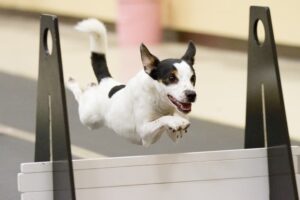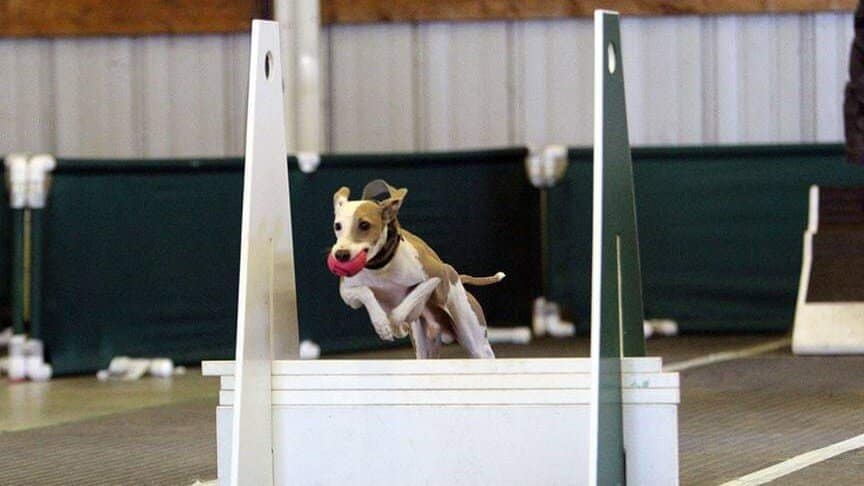
The American Kennel Club Brings the AKC Flyball Dog Challenge to ESPN2
The American Kennel Club (AKC) announces that the AKC Flyball Dog Challenge will air on ESPN2 on Saturday, March 25th, at 4 p.m. ET.
Home » Dog Sports » Flyball Dog Sport

Flyball is an exhilarating, lively, and fast-paced team sport for dogs that combines agility, speed, and precision. Originating in the late 20th century, Flyball has grown into a popular competitive sport for dogs and their handlers, marked by its dynamic nature and inclusive spirit.
In Flyball, teams of dogs race against each other from a start/finish line, over a series of hurdles, to a box that releases a tennis ball when the dog presses a spring-loaded pad. The dog catches the ball and then races back over the hurdles to the start/finish line. It is a relay race in essence, with four dogs comprising each team, sometimes barking raucously as they go. The key aspects of the sport include:
Flyball’s inception can be traced back to the late 1960s and early ‘70s, likely starting during dog training classes in California. The sport’s pioneer, Herbert Wagner, is often credited with developing the first Flyball box, which he later showcased on a national television show, The Tonight Show starring Johnny Carson. This initial concept combined elements of agility and fetching. Later, hurdles and racing were included to add a competitive edge.
As the sport gained popularity, the need for standardized rules became apparent. This led to the formation of the North American Flyball Association (NAFA) in 1984, which played a pivotal role in formalizing the sport’s guidelines and promoting its growth. The first official Flyball tournament, held in the early 1980s, marked the beginning of Flyball as a competitive sport, drawing significant interest from the dog enthusiast community.
The sport’s appeal, characterized by its inclusiveness and the excitement it generated, led to its rapid spread across North America and eventually to other continents, including Europe and Australia. Major canine organizations, such as the American Kennel Club (AKC) and the United Kennel Club (UKC), recognized Flyball, further legitimizing it within the canine sports community.
Over the years, Flyball has seen innovations, especially in the equipment used. The Flyball box, for example, focuses on safety for the dogs and efficiency in the sport. Today, the sport is celebrated for its diversity, with dogs of all breeds, mixes, and sizes participating. It emphasizes teamwork and the bond between the dog and handler, making it a favorite among dog owners. Flyball has developed a unique culture, characterized by community, sportsmanship, and fun. Annual tournaments and gatherings foster a strong sense of community among participants.
With its increasing recognition and a growing base of participants, Flyball is poised for further expansion, both in terms of participation and innovation. The sport continues to evolve, with a focus on enhancing training techniques, equipment, and competition formats, thus ensuring that Flyball remains an exciting and dynamic sport for future competitors to enjoy.
Flyball, as a dynamic and team-oriented sport, is supported and organized by several key bodies that play a crucial role in its regulation, promotion, and global reach. These organizations not only govern the sport but also foster a sense of community among Flyball enthusiasts.

The American Kennel Club (AKC) announces that the AKC Flyball Dog Challenge will air on ESPN2 on Saturday, March 25th, at 4 p.m. ET.